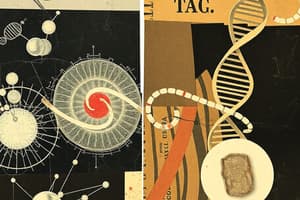Podcast
Questions and Answers
What is the main function of the nucleus in a cell?
What is the main function of the nucleus in a cell?
- Protein synthesis
- Photosynthesis
- Storage of genetic information (correct)
- Energy production
The nucleolus is part of the nuclear envelope.
The nucleolus is part of the nuclear envelope.
False (B)
What are the two types of chromatin found in the nucleus?
What are the two types of chromatin found in the nucleus?
Euchromatin and heterochromatin
The nucleus appears ______ due to the abundance of DNA.
The nucleus appears ______ due to the abundance of DNA.
Match the following terms with their definitions:
Match the following terms with their definitions:
Which of the following describes heterochromatin?
Which of the following describes heterochromatin?
The nucleolus is bound by membranes.
The nucleolus is bound by membranes.
What is the primary function of the nucleus?
What is the primary function of the nucleus?
The _____ contains a central fibrous area and an outer granular portion.
The _____ contains a central fibrous area and an outer granular portion.
Match the following components with their descriptions:
Match the following components with their descriptions:
Flashcards
Nucleus Shape
Nucleus Shape
Nuclei can be various shapes, including spherical, oval, indented (kidney-shaped), spiral, multilobed, or irregular.
Nuclear Envelope
Nuclear Envelope
A double membrane surrounding the nucleus, controlling the passage of materials between the nucleus and cytoplasm.
Nuclear Pores
Nuclear Pores
Openings in the nuclear envelope that allow substances to move between the nucleus and the cytoplasm.
Euchromatin
Euchromatin
Signup and view all the flashcards
Nucleus Location
Nucleus Location
Signup and view all the flashcards
Heterochromatin
Heterochromatin
Signup and view all the flashcards
Euchromatin
Euchromatin
Signup and view all the flashcards
Nucleolus
Nucleolus
Signup and view all the flashcards
Chromosome
Chromosome
Signup and view all the flashcards
Function of Nucleus
Function of Nucleus
Signup and view all the flashcards
Study Notes
Cell Biology and Physical Therapy
- The presented material is on cell biology, specifically the nucleus, and related concepts like cell cycle and cell death.
- The speaker is Dr. Manal M. Sayed
The Nucleus
- The nucleus is the cell part housing chromosomes, which carry genetic material.
- Nuclei exhibit diverse shapes: spherical, oval, indented (kidney-shaped), spiral, multilobed, lobulated, or irregular.
- Most cells are mononucleated; some are binucleated (e.g., liver cells), and others are multinucleated (e.g., skeletal muscle fibers).
- The nucleus's appearance can be deeply stained or vesicular (open face).
- The nucleus is always deeply basophilic due to the high DNA content.
Structure of the Nucleus
- The interphase nucleus, according to electron microscopy (EM), consists of a nuclear envelope, chromatin, nucleolus, and nucleoplasm.
- The nuclear envelope is a selective barrier between the nucleus and cytoplasm, appearing as two concentric membranes separated by a narrow perinuclear space (30–50 nm).
- Circular pores in the nuclear envelope facilitate substance exchange between the nucleus and cytoplasm.
- The nuclear envelope is a dark basophilic membrane.
Chromatin
- Chromatin is the substance of chromosomes, existing as:
- Euchromatin: dispersed, finely granulated, uncoiled, representing active parts of the chromosome.
- Heterochromatin: clumps, condensed, representing inactive, coiled parts of the chromosome.
Nucleolus
- The nucleolus is a generally spherical, highly basophilic structure often present in most cells.
- It's not membrane-bound.
- Ribosomal RNA (rRNA) is produced within the nucleolus.
- EM reveals two main regions: a central fibrous area (pars fibrosa) containing chromatin and filamentous RNA, and an outer granular portion (pars granulosa) containing RNA particles similar to ribosomal subunits.
Cell Cycle
- The cell cycle is a series of events leading to cell division.
- The cell cycle has two main periods: Interphase and Mitosis.
- Interphae includes G1, S, and G2 phases.
- G1 phase: Cell growth, longest phase, protein synthesis.
- S phase: DNA replication
- G2 phase: Short preparation period prior to mitosis, protein synthesis.
- Mitosis is the period of cell division, resulting in two daughter cells.
- Mitosis includes: prophase, metaphase, anaphase, telophase, cytokinesis. (details given on another page)
- Interphase is the interval between successive cell divisions, during which the cell carries out its specialized function.
Cell Death
- Cell death is the irreversible cessation of vital activities in a cell.
- Two main types of cell death are apoptosis and necrosis.
- Apoptosis is programmed cell death (normal and regulated).
- Necrosis is cell death caused by exogenous factors, such as injury or toxins (a pathological process).
Quiz Questions
- The outer membrane of the nuclear envelope is continuous with the rough endoplasmic reticulum.
- The period of DNA replication in the cell cycle is the S phase.
- Necrosis is cell death that results from disease or injury.
- Apoptosis is the normal cell death caused by internal factors.
Studying That Suits You
Use AI to generate personalized quizzes and flashcards to suit your learning preferences.




